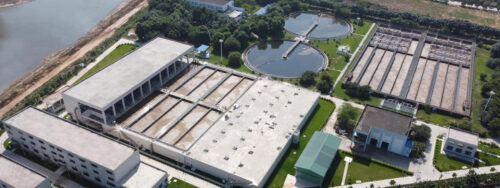Linking energy and wastewater infrastructure a triple win for climate, water, and operating costs
Keely Swan, Center for Policy Research on Energy and the Environment
Using sludge and reclaimed water from wastewater treatment plants as fuel and water sources at coal-fired power plants in China can save significant amounts of water, cut operating costs, and reduce greenhouse gas emissions.

Coal-fired power plants are the second largest water user in China, requiring large volumes of freshwater for processing coal and cooling, and contribute significantly to greenhouse gas emissions. Meanwhile, wastewater treatment plants generate millions of tons of sludge that must be disposed of and reclaimed water that can be reused for other purposes. By simply connecting these two industrial processes, wastewater treatment plants can serve as a steady source of water for coal power plants, reducing their freshwater consumption by 62%, and coal plants can co-burn the sludge as a fuel source to deliver greenhouse gas emission reductions equal to 29% of emissions by wastewater treatment plants.
Traditionally, scientists, planners and policymakers target one category of infrastructure at a time for improvements. But a new study by researchers at Princeton University and Tsinghua University demonstrates that pairing industrial processes can reduce greenhouse gas emissions and freshwater usage while also cutting operating costs. Their study analyzes actual potential for linking coal power and wastewater treatment facilities in China, quantifying the expected benefits and highlighting the most promising regions where this strategy could be utilized effectively.
“Detailed implementation plans for specific regions can be developed using our high-resolution results,” said Yang Guo, first author and an associate research scholar at the Center for Policy Research on Energy and the Environment at Princeton University. “Local governments can formulate tailored strategies based on our findings to balance environmental benefits with cost effectiveness and technical feasibility,” Guo said.
The researchers developed a database of around 2,400 coal-fired power plants and 4,200 municipal wastewater treatment plants across China. They found that by using reclaimed water from wastewater treatment plants as a water source for coal power generation, 3.0 billion m3 of freshwater – 62% of freshwater consumption by the coal power sector – could be conserved. In addition, 8.6 Megatons of CO2eq – 29% and 0.28% of GHG emissions from the wastewater treatment and coal power sectors, respectively – would be avoided. They find these efforts result in annual cost savings of more $1 Billion USD.
“Understanding and leveraging interactions among various sectors provides remarkable opportunities for increased sustainability and goes beyond what is possible when a single sector is addressed alone,” said Denise Mauzerall, a lead author and professor of civil and environmental engineering and international affairs at Princeton University and associate faculty at the Andlinger Center for Energy and the Environment.
The researchers also found that close proximities of coal-fired power plants and wastewater treatment plants in certain regions helped to maximize benefits by improving the feasibility of transporting water and sludge between facilities. According to the researchers, the results indicate that future urban planning should consider the proximity between power and waste treatment plants to maximize both environmental and economic benefits of infrastructure connections.
“Policies to boost the establishment of energy–water infrastructure symbiosis would cost-effectively facilitate the achievement of China’s climate and water targets,” Mauzerall said.
As countries work towards limiting greenhouse gas emissions and preparing infrastructure to be more resilient in response to climate change, novel approaches to link energy and water infrastructure in a more symbiotic relationship can help move the needle in achieving these targets.
“The energy–water infrastructure symbiosis we propose is a step towards an urban eco-transition that will facilitate more sustainable urban systems as society transitions away from fossil fuels entirely,” Mauzerall said.
This story originally appeared on the Center for Policy Research on Energy and the Environment website.